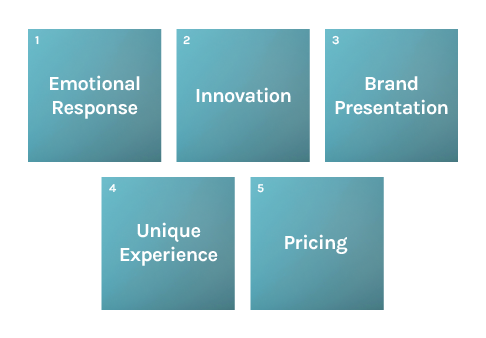In today’s hyper-competitive brand environment, where consumers are inundated by advertising and faced with a plethora of product choices, brands are struggling to stand out. But to grow and be successful, it is imperative that brands distinguish themselves in this crowded marketplace.
What is the best way to make this happen? How can you build a strong, compelling brand that is associated with key needs, benefits or desires that customers seek?
Here are five strategies to consider for driving home your brand’s points of differentiation:

1. Emotional Response
This relies on providing an emotional salience that is tied to a product or service. We’ve found that brands that develop an emotional connection with their customers are often better positioned that those that provide a superior value. For example, Coke’s advertising often appeals to emotion in order to establish a stronger connection with consumers. Their “Share A Coke – Share a feeling” and ‘’Hug me’’ campaigns illustrate just two of the ways that the company uses to evoke an emotional response.
2. Innovation
This can be expressed through physical characteristics of the products or the way in which a product or services is delivered. In short, this differentiation solves an unmet need in a unique and novel fashion. James Dyson is an example of someone who developed an innovative product (a vacuum cleaner) thus positioning his company as a leader in innovation. With this positioning, the company has gone on to continually innovate by bringing many other novel products to market.
3. Brand Presentation
How a brand presents itself to the market can be a differentiator. In this case, brands that employ a consistent character or mascot can be easily remembered and stand out in the crowd. The use of mascots can be particularly powerful when humor is used to shape brand perceptions. A prime example is Geico’s use of an animated lizard, which has nothing to do with insurance but has come to represent, and be strongly associate with, the brand over time.
How can you build a strong, compelling brand that is associated with key needs, benefits or desires that customers seek?”
4. Unique Experience
This can be manifest in several ways such as a brand’s physical retail presence, exceptional customer service, ease of use of their website, the novel environment that they create, or, simply, the experience of unboxing a product. Build-a-Bear offers children (and children at heart) the ability to custom design their own stuffed animals by selecting the color, style, size and even the amount of stuffing their animals contain. The experience the company offers is unmatched when it comes to toys.
5. Pricing
When handled properly, this can also be an effective approach to differentiation. On one end of the spectrum, a company can strive to be positioned as the ‘low price leader’ offering customers outstanding value. On the other end, they could be positioned as a premium brand at a high price. In some cases, an effective brand differentiation strategy can enable a brand to command a higher price premium than they otherwise could obtain. On the lower end, Walmart stores are known for their low prices and good values which has allowed the company to reshape retail. On the other end of the spectrum, Starbucks has convinced consumers that there is value in paying much more for coffee than they would have before the company disrupted the purchase of coffee.
How do you determine which of these strategies to deploy for brand differentiation?
Here’s the Radius 3-step approach:
1. Define your current target customer.
Characterize the type of customers that are most likely to currently purchase your product or service and then consider targets that could be adjacent, such as customers who would consider your brand, but have not yet purchased.
2. Determine which characteristics are important to these groups when evaluating a purchase.
For example, should your brand evoke an emotional response, provide a superior experience, or offer a compelling price point.
3. Assess how you are perceived vs. key competitors across these important dimensions.
Gaining perceptual insights is key to understanding the strengths and weaknesses in the market and to determining if there is white space that no brands currently occupy. Assuming that your brand has permission to occupy that space, this can be a very compelling way to differentiate your brand.
Want to learn more about taking a systematic assessment of driving brand differentiation?
Contact Us




